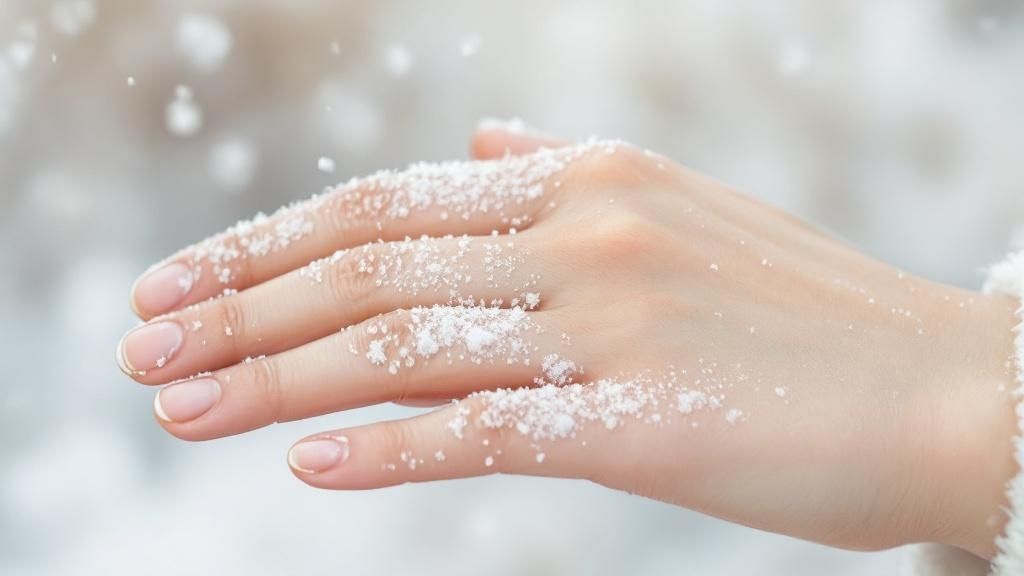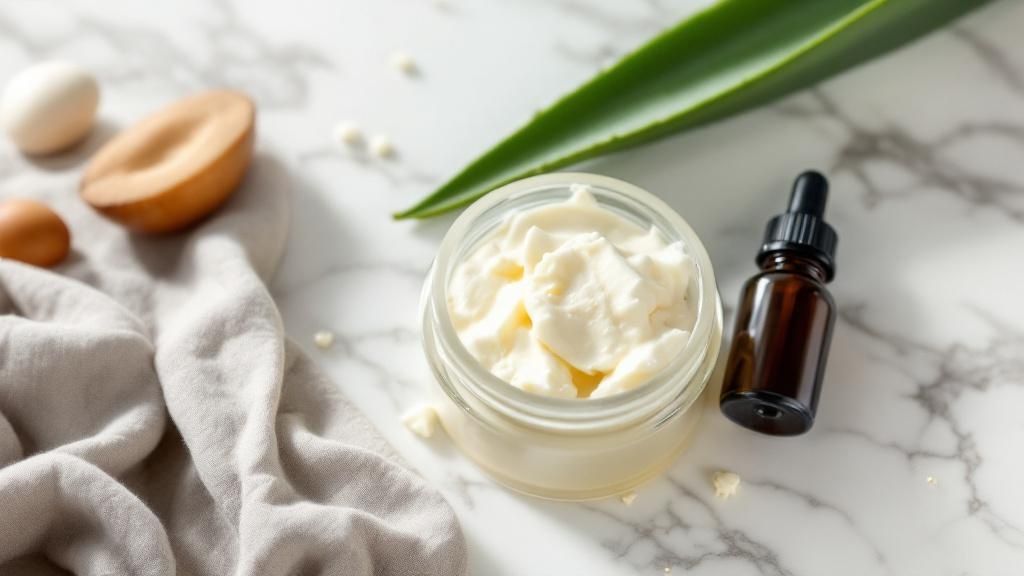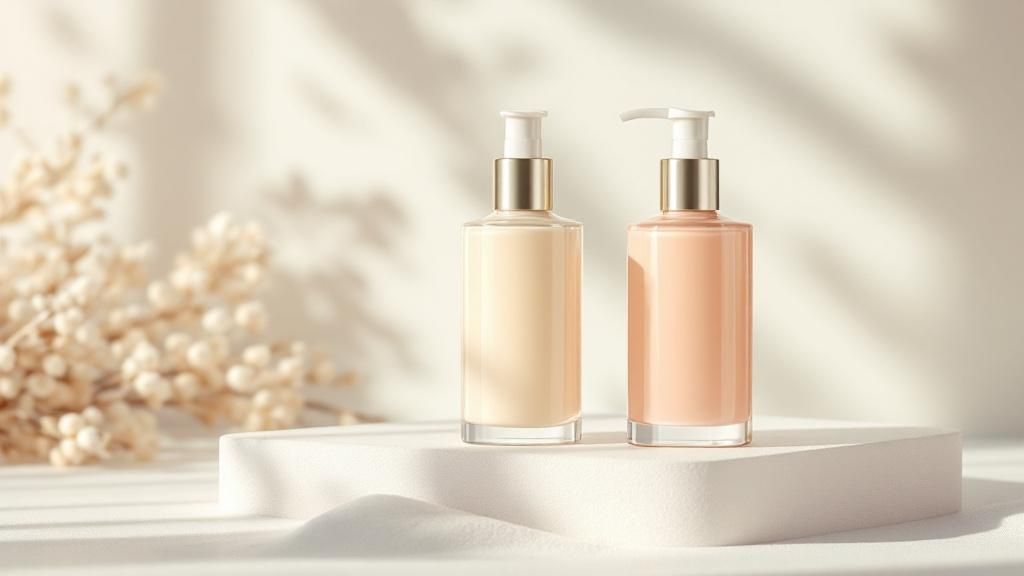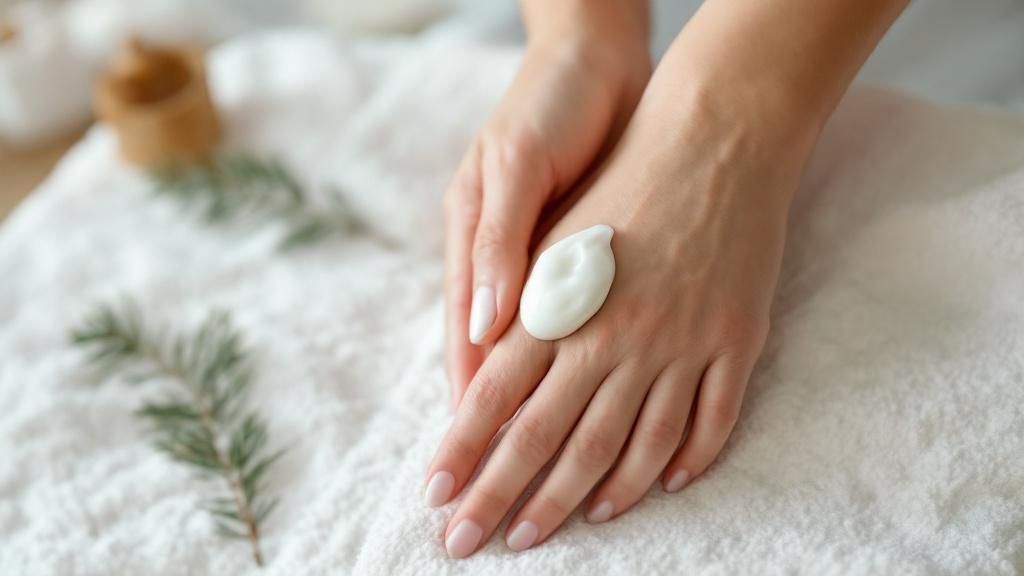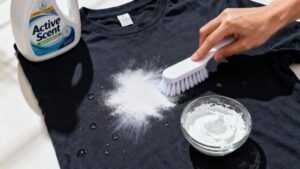
Finding the Best Lotion for Winter to Soothe Dry Skin
When the first cold snap hits, that lightweight lotion you loved all summer just won’t cut it. Finding the best lotion for winter is about more than just grabbing a thicker cream; it’s a strategic upgrade. Your skin needs a richer, more protective formula to stand up to the harsh realities of cold air and blasting indoor heat. Think of it like swapping a silk blouse for a cashmere sweater—it’s about providing the right kind of defense.
Why Your Skin Needs a Winter Upgrade
Imagine your skin as a protective shield. In the warmer months, the humid air helps keep that shield strong and hydrated. But winter completely changes the game. The brutal combination of frigid outdoor air and dry, recycled indoor heat creates the perfect storm for moisture loss.
This sudden environmental shift attacks your skin's natural defenses. The lipid barrier—the seal that locks in moisture—starts to weaken. This leads directly to something called transepidermal water loss (TEWL), a fancy term for hydration literally escaping from your skin into the dry air. In fact, water loss from your skin can skyrocket by as much as 25% during the winter.
The Cycle of Dryness
This is where the dreaded winter skin problems begin. It often starts with that tight, uncomfortable feeling, but it can quickly escalate to visible flaking, relentless itching, and even angry, red patches. The standard, breezy lotion that felt perfect in July simply doesn't have the power to reinforce your skin against this seasonal assault.
Your skin needs more than just a splash of moisture; it needs a fortress. A true winter lotion should act like a shield, not only replenishing lost hydration but creating a protective layer to stop it from escaping in the first place.
This need for seasonal skincare is no secret. The global market for winter care lotions was recently valued at around $1.2 billion, and it's set to grow as more people realize that one lotion doesn't fit all seasons.
Preparing Your Skin for the Cold
To truly fight back against winter dryness, you need a formula built for the job. A proper winter lotion delivers a much richer, more substantial barrier to lock in that precious hydration and bring back a feeling of comfort and softness. Our complete guide to finding the best body lotion for winter breaks down exactly what to look for.
Ultimately, making this switch is about being proactive. When you understand why your skin acts so differently in the cold, you can arm yourself with the right products to keep it smooth, resilient, and comfortable all winter long.
Decoding the Ingredients on Your Lotion Bottle
Flipping over a lotion bottle can feel like you’re trying to crack a code. The list of long, scientific-sounding names is enough to make anyone’s head spin. But here’s the secret: understanding these ingredients is your ticket to finding a truly effective winter moisturizer.
Most powerful lotions don’t just rely on one miracle ingredient. They assemble a team. Think of it like building a championship team for your skin's survival—you need different players with unique skills working in perfect harmony. In the world of skincare, this dream team is made up of humectants, emollients, and occlusives.
Once you know what each one does, you can scan any label and know exactly what that lotion will do for your skin. No more guesswork.
The Moisture Magnets: Humectants
First up, you have the humectants. These are your skin’s moisture magnets. Their primary job is to pull water molecules into the top layer of your skin, drawing hydration up from the deeper layers and even from the air around you.
This gives your skin that immediate, plumped-up feeling—like a desperately needed drink of water. But there's a catch. In the dry winter air, humectants can actually pull moisture out of your skin if they aren't paired with other ingredients. That’s why they can’t work alone.
Look for these on the label:
- Glycerin: The classic, reliable workhorse that’s incredibly effective and gentle.
- Hyaluronic Acid: This famous hydrator can hold up to 1,000 times its weight in water.
- Urea: A powerhouse that both hydrates and gently exfoliates away dry flakes.
- Lactic Acid: An alpha-hydroxy acid (AHA) that pulls in moisture while smoothing skin texture.
The Repair Crew: Emollients
Next on the team are the emollients. Think of them as the repair crew. While humectants are busy drawing in water, emollients get to work smoothing everything over. They are essentially fats and oils that fill in the microscopic gaps between your skin cells.
They’re like spackle for your skin’s barrier, turning rough, cracked patches into a soft, flexible surface. This is what tackles that tight, itchy feeling that plagues us all winter long.
A great lotion uses emollients to bring back that supple, comfortable feeling. Without them, your skin might feel hydrated, but it would still feel rough to the touch.
Keep an eye out for these essential emollients:
- Ceramides: These are lipids that your skin produces naturally, making them critical for a healthy, functioning barrier.
- Fatty Acids: Ingredients like linoleic and oleic acid that deeply nourish the skin.
- Squalane: A lightweight oil that feels amazing because it perfectly mimics your skin’s own natural oils.
The Security Guards: Occlusives
Finally, we bring in the occlusives. These are the security guards for your hydration team. After the humectants have brought moisture in and the emollients have smoothed the surface, occlusives create a protective, physical barrier on top.
This seal is what locks all that hard-earned moisture in, preventing it from escaping into the dry winter air—a process known as transepidermal water loss (TEWL). This is arguably the most crucial job for any winter lotion. These ingredients are what give a lotion that rich, protective feel that lasts for hours.
To see how it all comes together, you need to understand the role each ingredient type plays on your skin's team.
Your Winter Skin's Hydration Team
Here’s a simple breakdown of the three key players and what they do. A truly great winter formula will have a sophisticated blend of all three.
| Ingredient Type | Their Role | Common Examples |
|---|---|---|
| Humectants | Attract water to the skin | Glycerin, Hyaluronic Acid, Urea |
| Emollients | Smooth and repair the skin | Ceramides, Squalane, Fatty Acids |
| Occlusives | Lock in moisture | Shea Butter, Petrolatum, Dimethicone |
The best lotions for harsh winter weather will always feature this trifecta of ingredients. This ensures your skin isn't just getting a temporary dose of hydration—it's being truly repaired, nourished, and shielded from the elements.
Finding the Right Winter Armor for Your Skin
Let's be clear: choosing a winter lotion isn’t a one-size-fits-all deal. Think of it like dressing for the weather. You wouldn’t wear a heavy ski parka in a light drizzle, and your skin needs that same level of customized defense. A formula that feels like a godsend for thirsty, dry skin could feel like a suffocating oil slick on someone else.
The first, most crucial step is to understand your own skin. Winter’s harshness affects everyone differently, so the moisturizer your best friend swears by might be a total disaster for you.
For Dry or Very Dry Skin
If your skin is already on the dry side, winter can feel like a relentless attack. Skin gets tight, flaky, and can even crack painfully because it’s already bad at holding onto moisture. Your mission, should you choose to accept it, is to find a lotion that delivers an intense dose of hydration and then locks it in.
You'll want to look for thick, rich creams and balms that feel substantial. Your ingredient list should be a who's who of hydrating powerhouses.
- Key Ingredients: Zero in on formulas with high concentrations of ceramides, shea butter, petrolatum, and squalane.
- Best Bet: Products like Cetaphil Moisturizing Cream or Eucerin Advanced Repair Cream give you that dense, protective barrier your skin is crying out for. They prevent water from escaping and help heal the dryness you already have.
For Oily or Acne-Prone Skin
Winter can be a confusing time for oily skin. It might feel greasy on the surface but strangely tight and dehydrated underneath. That’s because the cold, dry air tricks your skin into overproducing oil to compensate, leading to clogged pores and breakouts on your face, chest, or back.
Your goal is to hydrate without adding heavy, pore-clogging gunk. A thick, greasy cream is your worst enemy.
Choosing a "non-comedogenic" lotion is absolutely non-negotiable. This label is your assurance that the formula was specifically designed not to clog your pores, so you can hydrate safely without waking up to new blemishes.
Look for lightweight lotions or gel-creams. These formulas sink in fast and feel fresh, not heavy.
- Key Ingredients: Make hyaluronic acid, glycerin, and niacinamide your top priorities. They deliver water-based hydration without any greasy feeling.
- Best Bet: A formula like Aveeno's Daily Moisturizing Lotion offers fantastic hydration that won’t feel heavy or trigger a breakout.
For Combination or Sensitive Skin
Combination skin is the classic "best of both worlds" dilemma—oily in some spots (like your T-zone) and dry in others (like your cheeks). Sensitive skin, meanwhile, can get angry about everything from harsh weather to a strong fragrance. Both demand a gentle, balanced approach.
You're looking for the Goldilocks of moisturizers: not too heavy, not too light, and completely free of common irritants. The perfect match will soothe inflammation while delivering just the right amount of moisture everywhere.
This need for targeted formulas isn't just a hunch; it's a massive global trend. Market research shows the demand for specialized winter lotions is highest in colder climates like North America and Europe, with giants like NIVEA, Vaseline, and Dove leading the charge. You can dig into the winter skincare market trends to see just how much geography influences what we buy.
Lotion vs. Cream vs. Ointment: What's the Difference?
When you walk down the skincare aisle, you're hit with a wall of moisturizers. The words lotion, cream, and ointment get thrown around so casually you'd think they were all the same. But they aren't—and knowing the difference is your secret weapon for choosing the best lotion for winter.
It all boils down to one simple thing: the ratio of water to oil. This single factor changes everything—how it feels, how it sinks in, and most importantly, how well it protects your skin from the cold. Think of it as a hydration scale, from a light touch to heavy-duty defense.
The Lightweight Option: Lotions
Lotions are the lightest of the bunch because they have the most water. They're fluid and thin, almost like a rich milk. They spread effortlessly and vanish into the skin in seconds, leaving behind no greasy film. It’s instant, weightless moisture.
This airiness makes lotions perfect for a few specific scenarios:
- Everyday, all-over body use when your skin doesn't need a heavy rescue.
- People with naturally oily skin who crave hydration without the clog.
- Humid summer days when you need a touch of moisture, not a thick shield.
But here’s the catch: that high water content is also their weakness in winter. The moisture can evaporate right off your skin, offering little to no lasting protection against biting winds and dry indoor heat.
The Balanced Choice: Creams
This is where creams come in. They are the perfect middle ground, with a balanced 50/50 blend of oil and water. If lotion is milk, think of cream as a luxurious yogurt—thicker, richer, and far more substantial. It takes a moment longer to absorb, but that's a good thing. It’s busy forming a protective barrier.
Creams are the hero of winter skincare for a reason. They deliver a one-two punch: the water hydrates, and the oil locks that hydration in, creating a seal against the elements.
This makes a cream your most reliable daily soldier for battling winter dryness on your arms, legs, and body. It provides serious comfort and relief without feeling like you're wearing a heavy mask.
The Heavy-Duty Protector: Ointments
Way over on the other end of the spectrum, you have ointments. These are almost pure oil. If creams are yogurt, ointments are butter—dense, semi-solid, and incredibly protective. Products like petroleum jelly or Aquaphor have very little water; their entire job is to create an unmatched, waterproof shield over your skin.
Ointments aren't for slathering on from head to toe. They are targeted problem-solvers, the special forces you call in for an emergency rescue mission on skin that's truly suffering.
Think of them for:
- Cracked knuckles and heels that feel raw from the cold.
- Chapped lips and any painfully irritated patches of skin.
- Rough, flaky elbows and knees that need intensive repair.
By understanding these roles, you can build a smarter winter skincare arsenal: a cream for your daily defense and an ointment for those targeted SOS moments.
How to Make Your Moisturizer Work Even Harder
Having the perfect winter lotion is one thing. Knowing how to use it is everything. The product you choose is only half the battle; how you apply it can turn a temporary fix into a powerful, long-lasting shield against the cold.
The single most important move? Timing. Apply your lotion right after a shower or bath, while your skin is still a little damp. This simple trick lets the moisturizer trap that surface water, locking it deep into your skin instead of letting it vanish into the dry winter air. Think of it like putting a lid on a pot—you're sealing in all the good stuff.
Make Consistency Your Winter Mantra
Consistency is the real secret to healthy winter skin. One random application here and there won’t do much when your skin is under constant assault from the elements. Get into the ritual of moisturizing your entire body at least once a day, ideally in that golden window right after you shower.
This daily practice reinforces your skin’s moisture barrier, making it stronger and more resilient over time. Don't gloss over the areas that take the most abuse.
- Hands: They’re always out in the cold and constantly being washed, which strips them of their natural oils. Make it a habit to put on lotion after every single hand wash.
- Feet: Often forgotten and stuffed into boots, your feet can get painfully dry and cracked. A thick, rich cream applied just before bed can work miracles overnight.
- Elbows and Knees: These spots have thicker skin and fewer oil glands, which is a recipe for roughness. They need a little extra love and attention.
Layering for Ultimate Protection
For those moments of extreme, stubborn dryness, think about layering your products just like you layer your winter clothes. You can start with a lighter, water-based serum or lotion to hydrate, and then seal it all in with a richer, more occlusive cream on top. It’s a multi-level defense system that hydrates deeply, then protects fiercely.
This idea of getting more from a single product is a huge deal in skincare right now. The demand for lotions that do more—blending hydration with things like SPF or anti-aging ingredients—is skyrocketing. People want smarter products that simplify their routines while delivering incredible results. You can even see how the industry is evolving by looking into the growth of these lotion and sunscreen combination products.
Key Takeaway: Your technique is just as crucial as the product itself. Applying to damp skin, sticking to a daily routine, and layering products are simple moves that make a dramatic difference in how your skin feels and looks.
Just as you layer skincare, the scents in your daily rituals can be layered to create a complete sensory experience. An exceptional fragrance doesn't just tell a story; it leaves a lasting impression. To see how a bold, unforgettable olfactory statement can elevate your routine, check out our guide to the best smelling laundry detergent.
Your Winter Lotion Questions Answered
Even with the best game plan, a few tricky questions always pop up when you're fighting the good fight against winter skin. It can feel like you’re missing a piece of the puzzle, but a few clear answers are all you need to lock in your strategy and feel amazing in your skin. Let's tackle the questions we hear the most.
Can I Use My Face Lotion on My Body in Winter?
While you technically can, it’s a move that’s neither effective nor economical. Think of it this way: the skin on your face is delicate, like silk. The skin on your body is tougher, more like denim.
Face lotions are formulated for that delicate facial skin—they're often lighter and, ounce for ounce, much more expensive. Your body needs something richer and more powerful to stand up to winter dryness. Sticking to a dedicated body lotion gives your skin the intense, targeted moisture it craves without burning through your pricey facial cream. It’s simply about using the right tool for the job.
How Often Should I Really Be Applying Lotion?
At an absolute minimum, once a day. The golden rule is to apply it right after you shower or bathe to trap all that wonderful moisture before it evaporates.
But the most important rule of all? Listen to your skin.
If it feels tight, looks ashy, or starts to itch, that's its way of telling you it's thirsty. For anyone with seriously dry skin or living in a brutal climate, reapplying once or twice more throughout the day is a great idea. And please, make it a non-negotiable ritual to moisturize your hands every single time you wash them.
Is a More Expensive Lotion Actually Better?
Not necessarily. A lotion’s real power isn’t in its price tag or a fancy bottle—it's hidden in the ingredients list. You can find incredible, dermatologist-recommended formulas in the drugstore aisle, packed with workhorses like ceramides, hyaluronic acid, and shea butter.
Instead of getting seduced by a high price, become an ingredient detective. A lotion's magic comes from having the right "Hydration Team"—humectants, emollients, and occlusives—working in harmony. You can find that winning combination at any price point.
Focus on the formula, not the fuss, and you’ll find a perfect match for your skin and your wallet.
What Does Non-Comedogenic Mean and Do I Need It?
"Non-comedogenic" is a term you'll want to know, especially if your skin leans oily or is prone to breakouts. It's a simple promise: the product has been formulated so it’s not likely to clog your pores. This is just as crucial in winter as it is in summer.
A thick, heavy cream might feel hydrating, but if it's not non-comedogenic, it can easily trigger breakouts on your face, chest, or back. If you get blemishes in those areas, looking for this label is your ticket to deep hydration without the fear of waking up to new pimples.
Even the small details of your daily routine, like your laundry, can have a big impact on sensitive skin. For those who believe gentleness and effectiveness should go hand-in-hand, you can learn more about finding the best smelling laundry detergent for sensitive skin in our related guide.
At Active Scent, we fuse powerful detergents with luxurious fragrances. Inspired by the spirit of iconic French houses like Dior, Mugler, and Chanel, our fragrances are bold, mysterious, hypnotic, and unforgettable olfactory statements. They don't just tell a story; they leave a lasting impression. LAUNDRY NEVER FELT SO GOOD! Discover our full collection.


